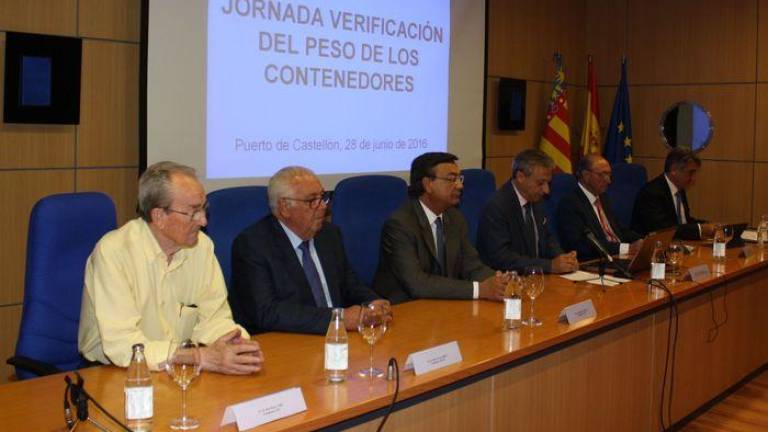Consulta cuando quieras la edición en Papel desde el lector de PDFs.
Pulsa aquí

La Autoridad Portuaria de Castellón ha reunido esta mañana a los sectores empresariales y agentes afectados por la nueva normativa española sobre verificación de la masa bruta de contenedores. Una normativa que tiene como objetivo garantizar que ninguno de los contenedores embarcados en los puertos españoles supere el peso máximo establecido y que entra en vigor el 1 de julio.
La inauguración de la jornada ha corrido a cargo del presidente de la Autoridad Portuaria de Castellón, Francisco Toledo; el presidente de Ascer, Isidro Zarzoso; el secretario general de ANFFECC, José Luis Breva; el presidente de la CEC, José Roca; y el presidente de ACEP, Sebastián Plá.
“El puerto de Castellón ha querido reunir a todos los eslabones que tienen relación con el tránsito de contenedores y que por tanto pueden ver afectada su operativa por la nueva normativa”, ha explicado Francisco Toledo. La reunión ha despertado el interés de alrededor de 120 personas, entre representantes de empresas terminalistas, consignatarias, transportistas y las organizaciones empresariales de Castellón mas implicadas con la entrada en vigor de la normativa, especialmente las dos patronales de material cerámico: Asociación Española de Fabricantes de Azulejos y Pavimentos Cerámicos –Ascer-- y la Asociación Nacional de Fabricantes de Fritas, Esmaltes y Colores Cerámicos –ANFFECC-.
El puerto de Castellón ocupa el quinto lugar en número de contenedores de import/export –objeto de la normativa-, al mover 194.411 contenedores durante el pasado año. La mayor parte de la mercancía que se exporta es material cerámico, en concreto 1.844.549 toneladas durante 2015. Los principales destinos son Israel, Argelia, Libano, Libia y Nigeria, tal y como ha expuesto el director del puerto de Castellón, Roberto Arzo.
Por su parte, el gerente de la Fundación PortCastelló, Miguel Rojo, ha explicado durante la jornada informativa los mecanismos que está aplicando el recinto portuario castellonense para “seguir dando la misma calidad de servicio”. Además ha intervenido el capitán marítimo de Castellón, José Manuel Manaute, quien se ha referido a la mejora que supondrá la nueva normativa para la seguridad marítima.
Hay que recordar que la modificación del Convenio SOLAS realizado por la Organización Marítima Internacional (OMI) exige que un contenedor tenga verificado el peso bruto como condición para cargarlo en un buque para exportación. Este cambio, que afecta a toda la industria del transporte marítimo en contenedor, responsabiliza al embarcador de obtener el peso bruto verificado de un contenedor lleno y de comunicarlo a la naviera para que lo pueda remitir a la terminal.
MEETINGS AND TALKS TO PROVIDE INFORMATION ABOUT THE WEIGHING OF CONTAINERS // The Port of Castellón has today called together business sectors and other agents that are affected by the new Spanish regulations concerning the verification of the gross weight of containers. These regulations, which come into force on the 1st July, are aimed at guaranteeing that no container loaded in a Spanish port exeeds the maximum weight permitted.
These sessions were inaugurated by the president of the Port Authority of Castellón, Francisco Toledo; the president of ASCER, Isidro Zarzoso; the secretary general of ANFFECC, José Luis Breva; the president of CEC, José Roca; and the president of ACEP, Sebastián Plá.
Francisco Toledo explained that, “The port of Castellón wanted to bring together all parties with a relationship to the transport of containers and who are therefore affected by these new regulations." The meeting brought together about 120 people, representitives of terminal operators, shipping agents, transport companies and the business organisations of Castellón most affected by the new regulations, especially organisations representing companies involved in the handling of material for the ceramics industry ASCER (Asociación Española de Fabricantes de Azulejos y Pavimentos Cerámicos) and ANFFECC (Asociación Nacional de Fabricantes de Fritas, Esmaltes y Colores Cerámico).
The port of Castellón holds fifth place in the Spanish ports system - where the regulations are to be applied - moving 194.411 containers last year. The greater part of the exported material is ceramics, specifically 1.844.549 tons in 2015. The main destinations are Israel, Algeria, Lebanon, Libya and Nigeria, as the director of the port of Castellón Roberto Arzo expalined.
For his part the mamanger of the PortCastelló Foundation, Miguel Rojo, explained the new system as it is now used in the port of Castellón "provides the same quality service". José Manuel Manuate, the Harbour Master of Castellón, underlined how the new regulations would improve safety at sea,
It may be remembered that the modification to the SOLAS agreement made by the International Maritime Organization (OMI) demands that conatainers have their gross weight verified as a previous condition to their being loaded aboard ship. This change, which affects the whole maritime transport industry, makes those loading the conatiner on board responsible for obtaining a certificate verifying the gross weight of a full container and giving this information to the ship owner so that it can, in turn, be given to the terminal.